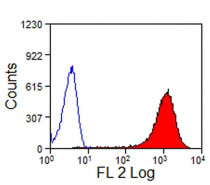ARG23408
anti-CD13 antibody [CVS19] (PE)
anti-CD13 antibody [CVS19] (PE) for Flow cytometry and Horse
Overview
| Product Description | PE-conjugated Mouse Monoclonal antibody [CVS19] recognizes CD13 Mouse anti Horse CD13 antibody, clone CVS19 recognizes the equine CD13 cell surface antigen, also known as Aminopeptidase N, a single-pass type II membrane protein belonging to the peptidase N family with a molecular weight of between 150 - 170 kDa.CD13 is widely expressed by a range of cell types including all blood neutrophils, basophils, monocytes, fibroblasts, kidney epithelial cells, endothelial cells and mesenchymal stem cells, but not by T or B cells. It is involved in a broad spectrum of biological processes and is believed to be linked to a number of disease states including tumor invasion (Saiki et al. 1993).Mouse anti Horse CD13 antibody, clone CVS19 may be used for differentiating myeloid and lymphoid linage cells in tumors of the haematopoietic system.In addition to clone CVS19, other CVS clones recognising equine MHC and cell surface antigens are available. |
|---|---|
| Tested Reactivity | Hrs |
| Tested Application | FACS |
| Host | Mouse |
| Clonality | Monoclonal |
| Clone | CVS19 |
| Isotype | IgG1 |
| Target Name | CD13 |
| Antigen Species | Horse |
| Immunogen | Equine leucocytes. |
| Conjugation | PE |
| Alternate Names | AP-N; PEPN; LAP1; CD antigen CD13; Aminopeptidase M; gp150; Aminopeptidase N; EC 3.4.11.2; Myeloid plasma membrane glycoprotein CD13; APN; CD13; P150; AP-M; GP150; hAPN; Microsomal aminopeptidase; Alanyl aminopeptidase |
Application Instructions
| Application Suggestion |
|
||||
|---|---|---|---|---|---|
| Application Note | FACS: Use 10 µl of the suggested working dilution to label 10^6 cells in 100 µl. * The dilutions indicate recommended starting dilutions and the optimal dilutions or concentrations should be determined by the scientist. |
Properties
| Form | Liquid |
|---|---|
| Purification | Purification with Protein G. |
| Buffer | PBS, 0.09% Sodium azide, 1% BSA and 5% Sucrose. |
| Preservative | 0.09% Sodium azide |
| Stabilizer | 1% BSA and 5% Sucrose |
| Storage Instruction | Aliquot and store in the dark at 2-8°C. Keep protected from prolonged exposure to light. Avoid repeated freeze/thaw cycles. Suggest spin the vial prior to opening. The antibody solution should be gently mixed before use. |
| Note | For laboratory research only, not for drug, diagnostic or other use. |
Bioinformation
| Gene Symbol | ANPEP |
|---|---|
| Gene Full Name | alanyl (membrane) aminopeptidase |
| Background | Aminopeptidase N is located in the small-intestinal and renal microvillar membrane, and also in other plasma membranes. In the small intestine aminopeptidase N plays a role in the final digestion of peptides generated from hydrolysis of proteins by gastric and pancreatic proteases. Its function in proximal tubular epithelial cells and other cell types is less clear. The large extracellular carboxyterminal domain contains a pentapeptide consensus sequence characteristic of members of the zinc-binding metalloproteinase superfamily. Sequence comparisons with known enzymes of this class showed that CD13 and aminopeptidase N are identical. The latter enzyme was thought to be involved in the metabolism of regulatory peptides by diverse cell types, including small intestinal and renal tubular epithelial cells, macrophages, granulocytes, and synaptic membranes from the CNS. Human aminopeptidase N is a receptor for one strain of human coronavirus that is an important cause of upper respiratory tract infections. Defects in this gene appear to be a cause of various types of leukemia or lymphoma. [provided by RefSeq, Jul 2008] |
| Function | Broad specificity aminopeptidase. Plays a role in the final digestion of peptides generated from hydrolysis of proteins by gastric and pancreatic proteases. May play a critical role in the pathogenesis of cholesterol gallstone disease. May be involved in the metabolism of regulatory peptides of diverse cell types, responsible for the processing of peptide hormones, such as angiotensin III and IV, neuropeptides, and chemokines. Found to cleave antigen peptides bound to major histocompatibility complex class II molecules of presenting cells and to degrade neurotransmitters at synaptic junctions. Is also implicated as a regulator of IL-8 bioavailability in the endometrium, and therefore may contribute to the regulation of angiogenesis. Is used as a marker for acute myeloid leukemia and plays a role in tumor invasion. In case of human coronavirus 229E (HCoV-229E) infection, serves as receptor for HCoV-229E spike glycoprotein. Mediates as well human cytomegalovirus (HCMV) infection. [UniProt] |
| Calculated MW | 110 kDa |
| PTM | Sulfated. N- and O-glycosylated. May undergo proteolysis and give rise to a soluble form. [UniProt] |
Images (1) Click the Picture to Zoom In






